Holmes Institute HI6028 Taxation Law Assignment: GST and CGT Analysis
VerifiedAdded on 2022/10/14
|10
|2197
|14
Homework Assignment
AI Summary
This taxation law assignment analyzes two key areas: Goods and Services Tax (GST) and Capital Gains Tax (CGT). The first section examines whether the City Sky Co. is entitled to input tax credits, considering GST registration, creditable acquisitions, and the application of relevant sections of the GST Act, including the case of HP Mercantile Pty Ltd v Commissioner of Taxation. The analysis determines the claimable input tax credit amount based on legal service costs. The second section evaluates the CGT implications for Emma's transactions, including the sale of land, shares, and a stamp collection, and the sale of a grand piano. It applies provisions of the Income Tax Assessment Act 1997 (ITAA 1997), calculating cost bases, proceeds, capital gains, and losses, and determining the overall CGT liability, including the application of the 50% discount for capital gains and the treatment of collectible assets.
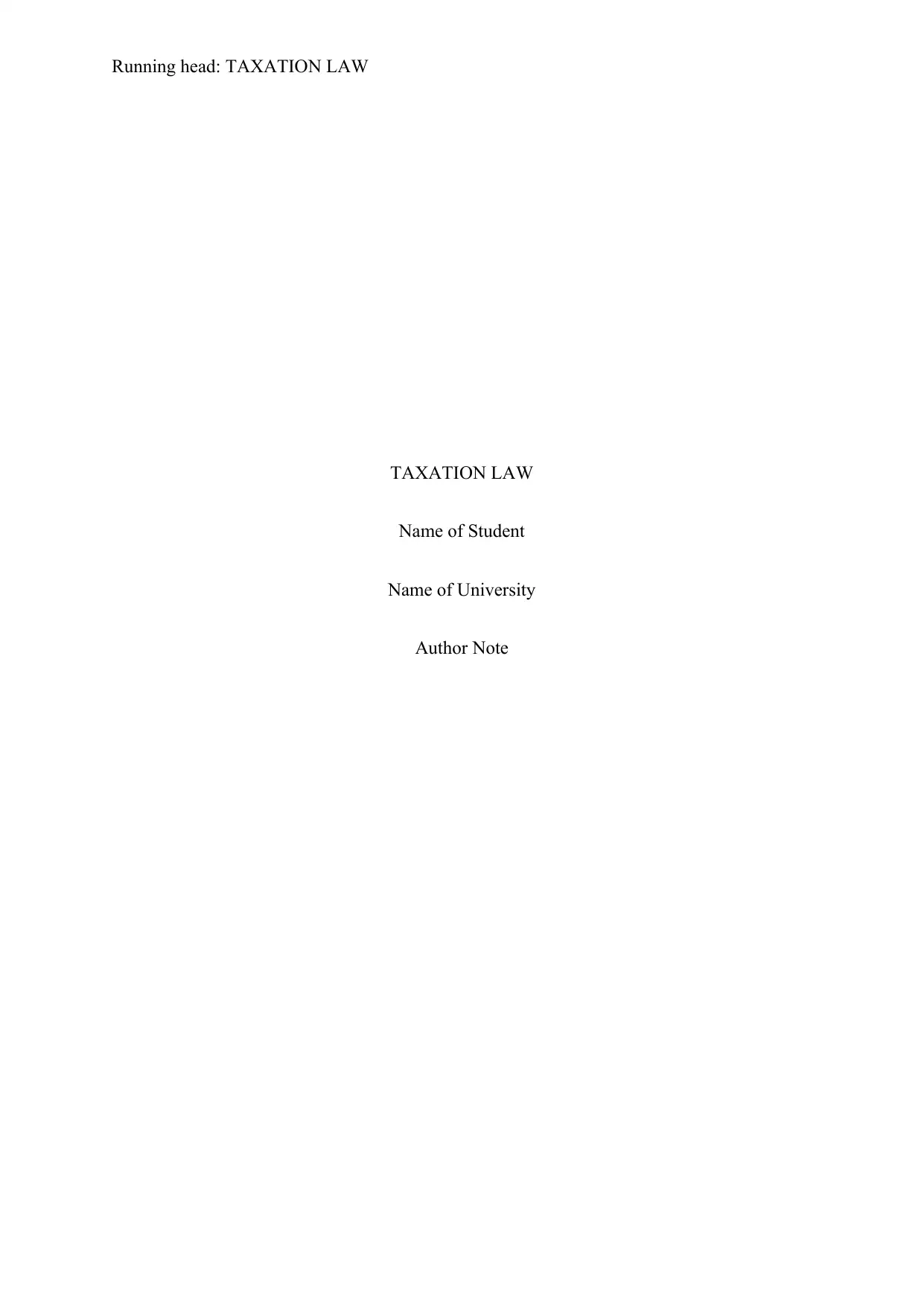
Running head: TAXATION LAW
TAXATION LAW
Name of Student
Name of University
Author Note
TAXATION LAW
Name of Student
Name of University
Author Note
Paraphrase This Document
Need a fresh take? Get an instant paraphrase of this document with our AI Paraphraser
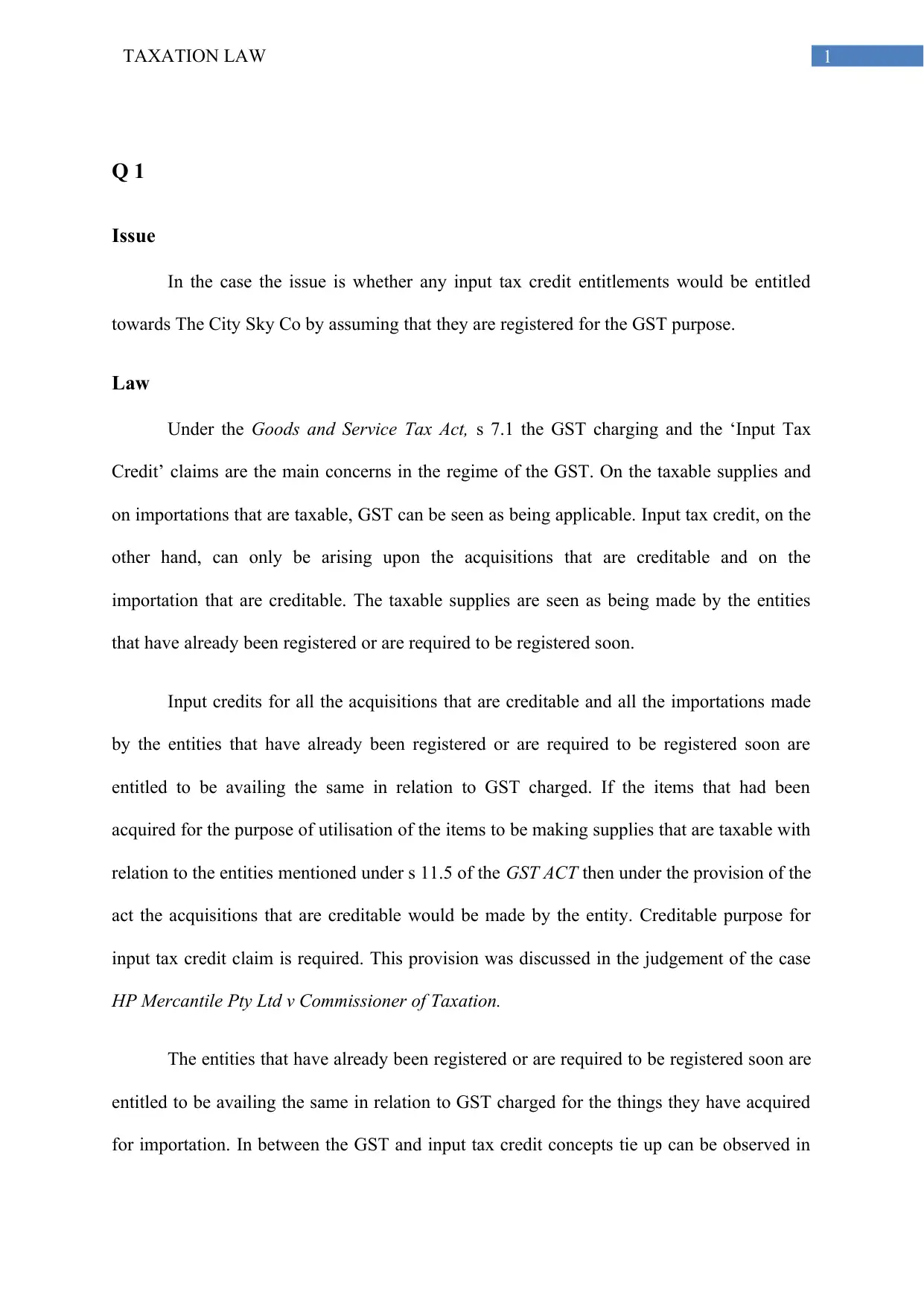
1TAXATION LAW
Q 1
Issue
In the case the issue is whether any input tax credit entitlements would be entitled
towards The City Sky Co by assuming that they are registered for the GST purpose.
Law
Under the Goods and Service Tax Act, s 7.1 the GST charging and the ‘Input Tax
Credit’ claims are the main concerns in the regime of the GST. On the taxable supplies and
on importations that are taxable, GST can be seen as being applicable. Input tax credit, on the
other hand, can only be arising upon the acquisitions that are creditable and on the
importation that are creditable. The taxable supplies are seen as being made by the entities
that have already been registered or are required to be registered soon.
Input credits for all the acquisitions that are creditable and all the importations made
by the entities that have already been registered or are required to be registered soon are
entitled to be availing the same in relation to GST charged. If the items that had been
acquired for the purpose of utilisation of the items to be making supplies that are taxable with
relation to the entities mentioned under s 11.5 of the GST ACT then under the provision of the
act the acquisitions that are creditable would be made by the entity. Creditable purpose for
input tax credit claim is required. This provision was discussed in the judgement of the case
HP Mercantile Pty Ltd v Commissioner of Taxation.
The entities that have already been registered or are required to be registered soon are
entitled to be availing the same in relation to GST charged for the things they have acquired
for importation. In between the GST and input tax credit concepts tie up can be observed in
Q 1
Issue
In the case the issue is whether any input tax credit entitlements would be entitled
towards The City Sky Co by assuming that they are registered for the GST purpose.
Law
Under the Goods and Service Tax Act, s 7.1 the GST charging and the ‘Input Tax
Credit’ claims are the main concerns in the regime of the GST. On the taxable supplies and
on importations that are taxable, GST can be seen as being applicable. Input tax credit, on the
other hand, can only be arising upon the acquisitions that are creditable and on the
importation that are creditable. The taxable supplies are seen as being made by the entities
that have already been registered or are required to be registered soon.
Input credits for all the acquisitions that are creditable and all the importations made
by the entities that have already been registered or are required to be registered soon are
entitled to be availing the same in relation to GST charged. If the items that had been
acquired for the purpose of utilisation of the items to be making supplies that are taxable with
relation to the entities mentioned under s 11.5 of the GST ACT then under the provision of the
act the acquisitions that are creditable would be made by the entity. Creditable purpose for
input tax credit claim is required. This provision was discussed in the judgement of the case
HP Mercantile Pty Ltd v Commissioner of Taxation.
The entities that have already been registered or are required to be registered soon are
entitled to be availing the same in relation to GST charged for the things they have acquired
for importation. In between the GST and input tax credit concepts tie up can be observed in
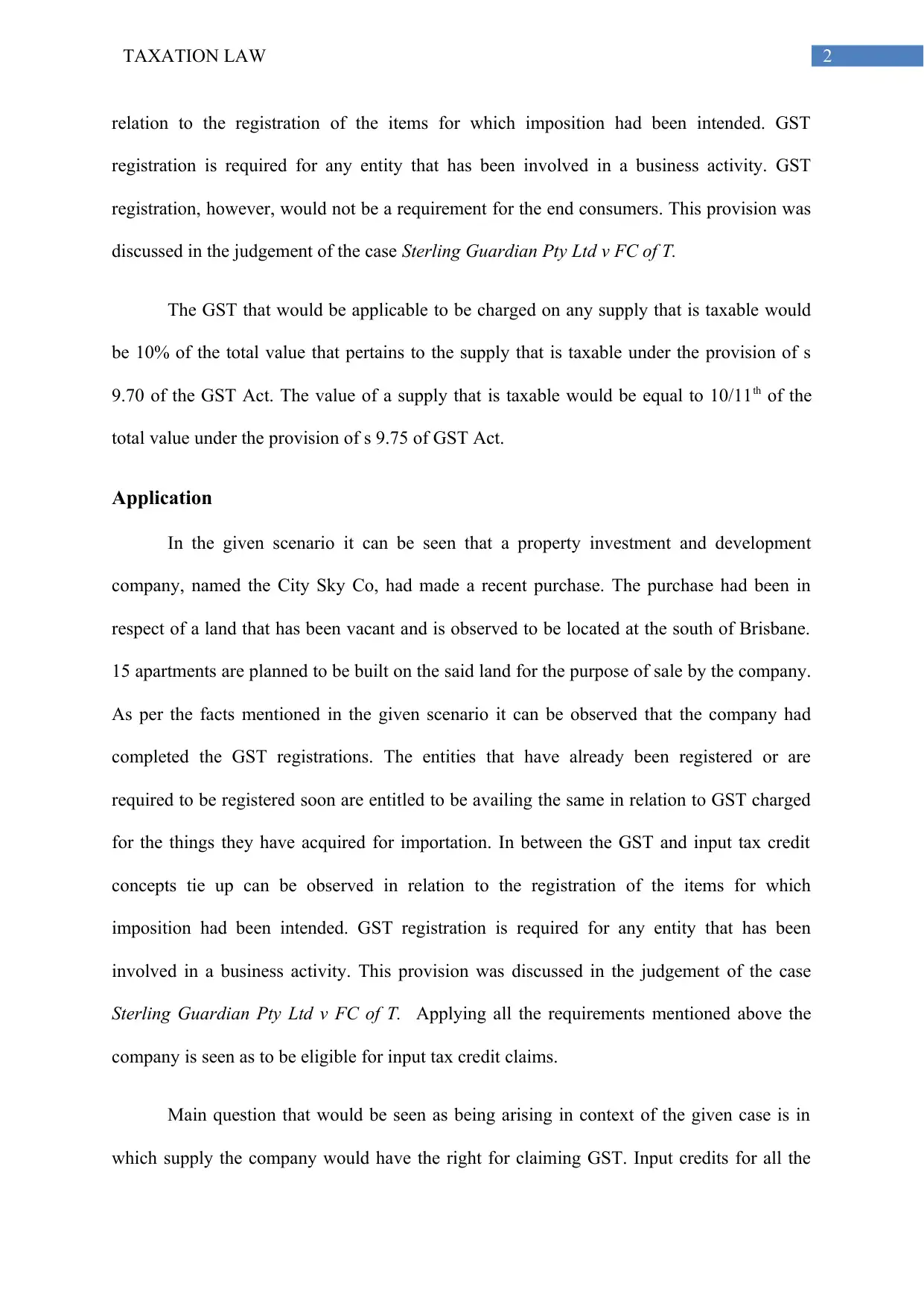
2TAXATION LAW
relation to the registration of the items for which imposition had been intended. GST
registration is required for any entity that has been involved in a business activity. GST
registration, however, would not be a requirement for the end consumers. This provision was
discussed in the judgement of the case Sterling Guardian Pty Ltd v FC of T.
The GST that would be applicable to be charged on any supply that is taxable would
be 10% of the total value that pertains to the supply that is taxable under the provision of s
9.70 of the GST Act. The value of a supply that is taxable would be equal to 10/11th of the
total value under the provision of s 9.75 of GST Act.
Application
In the given scenario it can be seen that a property investment and development
company, named the City Sky Co, had made a recent purchase. The purchase had been in
respect of a land that has been vacant and is observed to be located at the south of Brisbane.
15 apartments are planned to be built on the said land for the purpose of sale by the company.
As per the facts mentioned in the given scenario it can be observed that the company had
completed the GST registrations. The entities that have already been registered or are
required to be registered soon are entitled to be availing the same in relation to GST charged
for the things they have acquired for importation. In between the GST and input tax credit
concepts tie up can be observed in relation to the registration of the items for which
imposition had been intended. GST registration is required for any entity that has been
involved in a business activity. This provision was discussed in the judgement of the case
Sterling Guardian Pty Ltd v FC of T. Applying all the requirements mentioned above the
company is seen as to be eligible for input tax credit claims.
Main question that would be seen as being arising in context of the given case is in
which supply the company would have the right for claiming GST. Input credits for all the
relation to the registration of the items for which imposition had been intended. GST
registration is required for any entity that has been involved in a business activity. GST
registration, however, would not be a requirement for the end consumers. This provision was
discussed in the judgement of the case Sterling Guardian Pty Ltd v FC of T.
The GST that would be applicable to be charged on any supply that is taxable would
be 10% of the total value that pertains to the supply that is taxable under the provision of s
9.70 of the GST Act. The value of a supply that is taxable would be equal to 10/11th of the
total value under the provision of s 9.75 of GST Act.
Application
In the given scenario it can be seen that a property investment and development
company, named the City Sky Co, had made a recent purchase. The purchase had been in
respect of a land that has been vacant and is observed to be located at the south of Brisbane.
15 apartments are planned to be built on the said land for the purpose of sale by the company.
As per the facts mentioned in the given scenario it can be observed that the company had
completed the GST registrations. The entities that have already been registered or are
required to be registered soon are entitled to be availing the same in relation to GST charged
for the things they have acquired for importation. In between the GST and input tax credit
concepts tie up can be observed in relation to the registration of the items for which
imposition had been intended. GST registration is required for any entity that has been
involved in a business activity. This provision was discussed in the judgement of the case
Sterling Guardian Pty Ltd v FC of T. Applying all the requirements mentioned above the
company is seen as to be eligible for input tax credit claims.
Main question that would be seen as being arising in context of the given case is in
which supply the company would have the right for claiming GST. Input credits for all the
⊘ This is a preview!⊘
Do you want full access?
Subscribe today to unlock all pages.

Trusted by 1+ million students worldwide
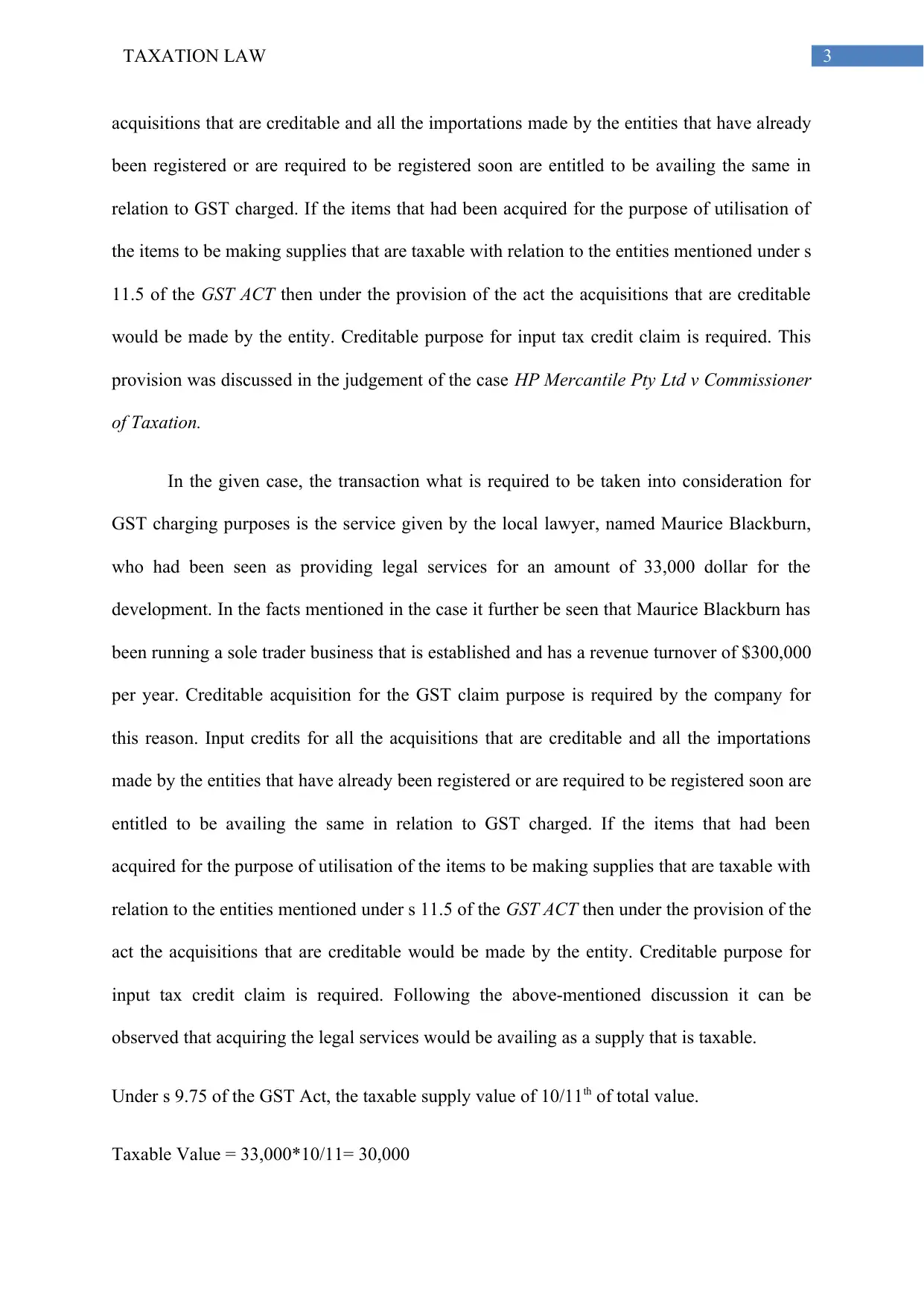
3TAXATION LAW
acquisitions that are creditable and all the importations made by the entities that have already
been registered or are required to be registered soon are entitled to be availing the same in
relation to GST charged. If the items that had been acquired for the purpose of utilisation of
the items to be making supplies that are taxable with relation to the entities mentioned under s
11.5 of the GST ACT then under the provision of the act the acquisitions that are creditable
would be made by the entity. Creditable purpose for input tax credit claim is required. This
provision was discussed in the judgement of the case HP Mercantile Pty Ltd v Commissioner
of Taxation.
In the given case, the transaction what is required to be taken into consideration for
GST charging purposes is the service given by the local lawyer, named Maurice Blackburn,
who had been seen as providing legal services for an amount of 33,000 dollar for the
development. In the facts mentioned in the case it further be seen that Maurice Blackburn has
been running a sole trader business that is established and has a revenue turnover of $300,000
per year. Creditable acquisition for the GST claim purpose is required by the company for
this reason. Input credits for all the acquisitions that are creditable and all the importations
made by the entities that have already been registered or are required to be registered soon are
entitled to be availing the same in relation to GST charged. If the items that had been
acquired for the purpose of utilisation of the items to be making supplies that are taxable with
relation to the entities mentioned under s 11.5 of the GST ACT then under the provision of the
act the acquisitions that are creditable would be made by the entity. Creditable purpose for
input tax credit claim is required. Following the above-mentioned discussion it can be
observed that acquiring the legal services would be availing as a supply that is taxable.
Under s 9.75 of the GST Act, the taxable supply value of 10/11th of total value.
Taxable Value = 33,000*10/11= 30,000
acquisitions that are creditable and all the importations made by the entities that have already
been registered or are required to be registered soon are entitled to be availing the same in
relation to GST charged. If the items that had been acquired for the purpose of utilisation of
the items to be making supplies that are taxable with relation to the entities mentioned under s
11.5 of the GST ACT then under the provision of the act the acquisitions that are creditable
would be made by the entity. Creditable purpose for input tax credit claim is required. This
provision was discussed in the judgement of the case HP Mercantile Pty Ltd v Commissioner
of Taxation.
In the given case, the transaction what is required to be taken into consideration for
GST charging purposes is the service given by the local lawyer, named Maurice Blackburn,
who had been seen as providing legal services for an amount of 33,000 dollar for the
development. In the facts mentioned in the case it further be seen that Maurice Blackburn has
been running a sole trader business that is established and has a revenue turnover of $300,000
per year. Creditable acquisition for the GST claim purpose is required by the company for
this reason. Input credits for all the acquisitions that are creditable and all the importations
made by the entities that have already been registered or are required to be registered soon are
entitled to be availing the same in relation to GST charged. If the items that had been
acquired for the purpose of utilisation of the items to be making supplies that are taxable with
relation to the entities mentioned under s 11.5 of the GST ACT then under the provision of the
act the acquisitions that are creditable would be made by the entity. Creditable purpose for
input tax credit claim is required. Following the above-mentioned discussion it can be
observed that acquiring the legal services would be availing as a supply that is taxable.
Under s 9.75 of the GST Act, the taxable supply value of 10/11th of total value.
Taxable Value = 33,000*10/11= 30,000
Paraphrase This Document
Need a fresh take? Get an instant paraphrase of this document with our AI Paraphraser
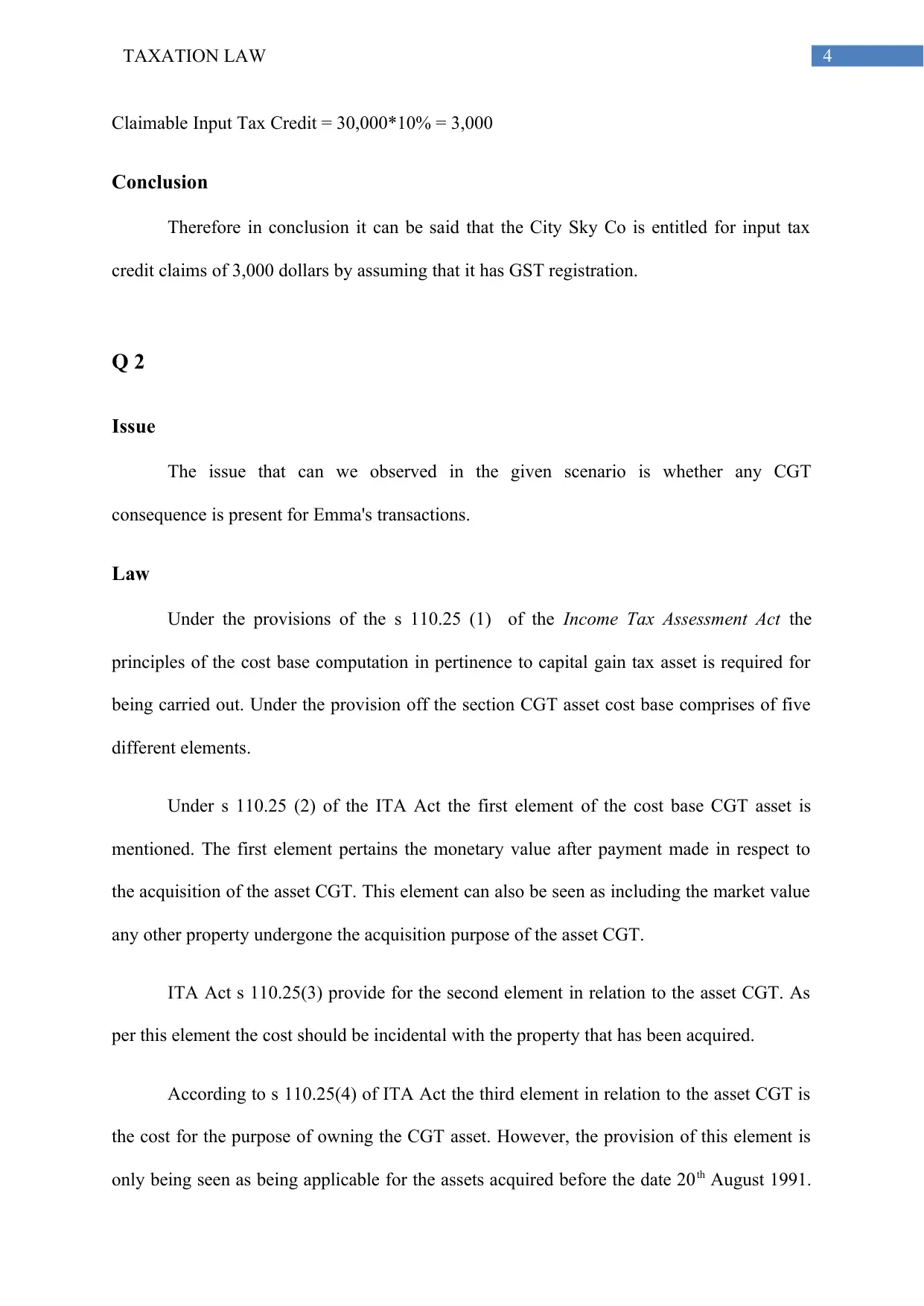
4TAXATION LAW
Claimable Input Tax Credit = 30,000*10% = 3,000
Conclusion
Therefore in conclusion it can be said that the City Sky Co is entitled for input tax
credit claims of 3,000 dollars by assuming that it has GST registration.
Q 2
Issue
The issue that can we observed in the given scenario is whether any CGT
consequence is present for Emma's transactions.
Law
Under the provisions of the s 110.25 (1) of the Income Tax Assessment Act the
principles of the cost base computation in pertinence to capital gain tax asset is required for
being carried out. Under the provision off the section CGT asset cost base comprises of five
different elements.
Under s 110.25 (2) of the ITA Act the first element of the cost base CGT asset is
mentioned. The first element pertains the monetary value after payment made in respect to
the acquisition of the asset CGT. This element can also be seen as including the market value
any other property undergone the acquisition purpose of the asset CGT.
ITA Act s 110.25(3) provide for the second element in relation to the asset CGT. As
per this element the cost should be incidental with the property that has been acquired.
According to s 110.25(4) of ITA Act the third element in relation to the asset CGT is
the cost for the purpose of owning the CGT asset. However, the provision of this element is
only being seen as being applicable for the assets acquired before the date 20th August 1991.
Claimable Input Tax Credit = 30,000*10% = 3,000
Conclusion
Therefore in conclusion it can be said that the City Sky Co is entitled for input tax
credit claims of 3,000 dollars by assuming that it has GST registration.
Q 2
Issue
The issue that can we observed in the given scenario is whether any CGT
consequence is present for Emma's transactions.
Law
Under the provisions of the s 110.25 (1) of the Income Tax Assessment Act the
principles of the cost base computation in pertinence to capital gain tax asset is required for
being carried out. Under the provision off the section CGT asset cost base comprises of five
different elements.
Under s 110.25 (2) of the ITA Act the first element of the cost base CGT asset is
mentioned. The first element pertains the monetary value after payment made in respect to
the acquisition of the asset CGT. This element can also be seen as including the market value
any other property undergone the acquisition purpose of the asset CGT.
ITA Act s 110.25(3) provide for the second element in relation to the asset CGT. As
per this element the cost should be incidental with the property that has been acquired.
According to s 110.25(4) of ITA Act the third element in relation to the asset CGT is
the cost for the purpose of owning the CGT asset. However, the provision of this element is
only being seen as being applicable for the assets acquired before the date 20th August 1991.
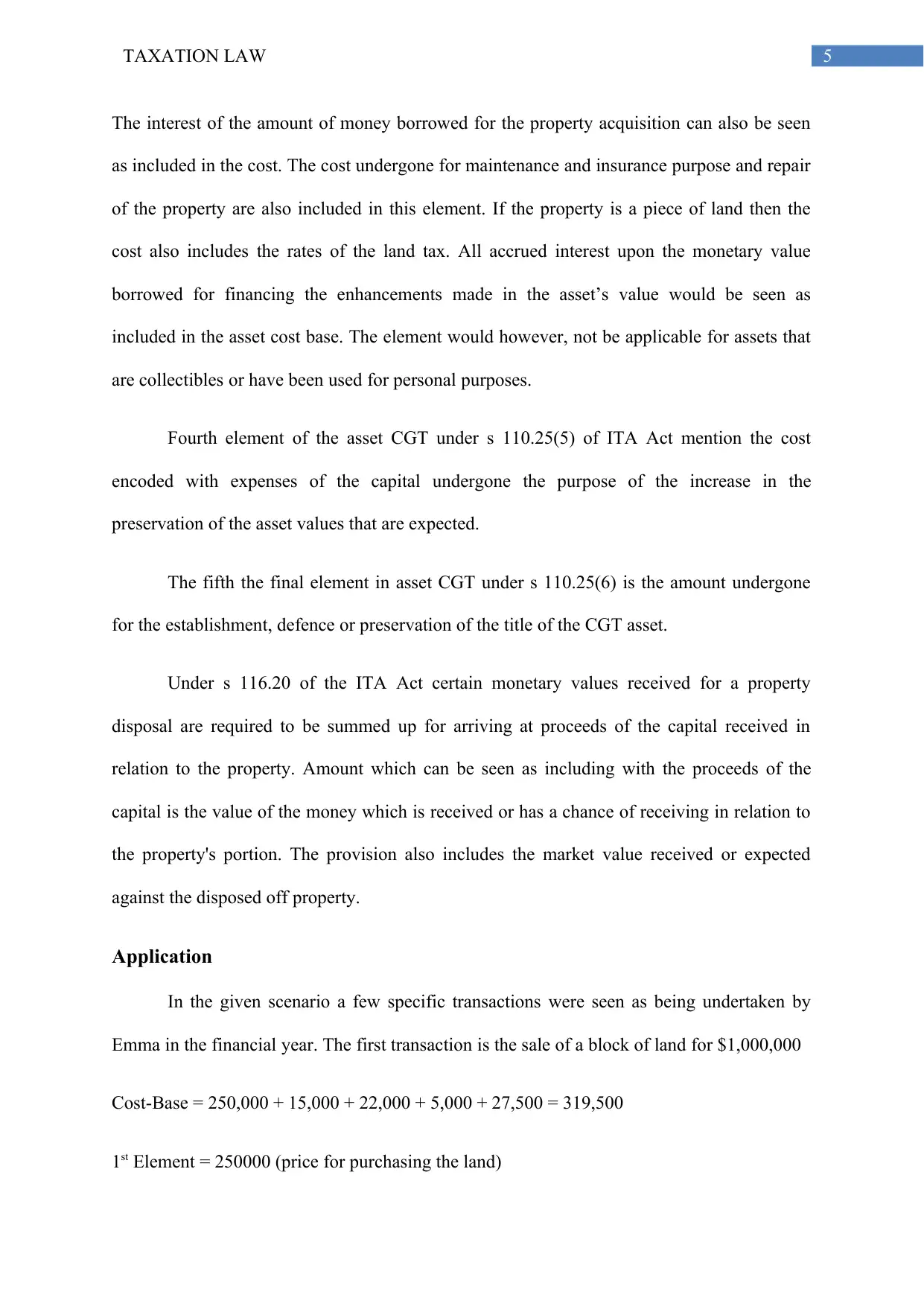
5TAXATION LAW
The interest of the amount of money borrowed for the property acquisition can also be seen
as included in the cost. The cost undergone for maintenance and insurance purpose and repair
of the property are also included in this element. If the property is a piece of land then the
cost also includes the rates of the land tax. All accrued interest upon the monetary value
borrowed for financing the enhancements made in the asset’s value would be seen as
included in the asset cost base. The element would however, not be applicable for assets that
are collectibles or have been used for personal purposes.
Fourth element of the asset CGT under s 110.25(5) of ITA Act mention the cost
encoded with expenses of the capital undergone the purpose of the increase in the
preservation of the asset values that are expected.
The fifth the final element in asset CGT under s 110.25(6) is the amount undergone
for the establishment, defence or preservation of the title of the CGT asset.
Under s 116.20 of the ITA Act certain monetary values received for a property
disposal are required to be summed up for arriving at proceeds of the capital received in
relation to the property. Amount which can be seen as including with the proceeds of the
capital is the value of the money which is received or has a chance of receiving in relation to
the property's portion. The provision also includes the market value received or expected
against the disposed off property.
Application
In the given scenario a few specific transactions were seen as being undertaken by
Emma in the financial year. The first transaction is the sale of a block of land for $1,000,000
Cost-Base = 250,000 + 15,000 + 22,000 + 5,000 + 27,500 = 319,500
1st Element = 250000 (price for purchasing the land)
The interest of the amount of money borrowed for the property acquisition can also be seen
as included in the cost. The cost undergone for maintenance and insurance purpose and repair
of the property are also included in this element. If the property is a piece of land then the
cost also includes the rates of the land tax. All accrued interest upon the monetary value
borrowed for financing the enhancements made in the asset’s value would be seen as
included in the asset cost base. The element would however, not be applicable for assets that
are collectibles or have been used for personal purposes.
Fourth element of the asset CGT under s 110.25(5) of ITA Act mention the cost
encoded with expenses of the capital undergone the purpose of the increase in the
preservation of the asset values that are expected.
The fifth the final element in asset CGT under s 110.25(6) is the amount undergone
for the establishment, defence or preservation of the title of the CGT asset.
Under s 116.20 of the ITA Act certain monetary values received for a property
disposal are required to be summed up for arriving at proceeds of the capital received in
relation to the property. Amount which can be seen as including with the proceeds of the
capital is the value of the money which is received or has a chance of receiving in relation to
the property's portion. The provision also includes the market value received or expected
against the disposed off property.
Application
In the given scenario a few specific transactions were seen as being undertaken by
Emma in the financial year. The first transaction is the sale of a block of land for $1,000,000
Cost-Base = 250,000 + 15,000 + 22,000 + 5,000 + 27,500 = 319,500
1st Element = 250000 (price for purchasing the land)
⊘ This is a preview!⊘
Do you want full access?
Subscribe today to unlock all pages.

Trusted by 1+ million students worldwide
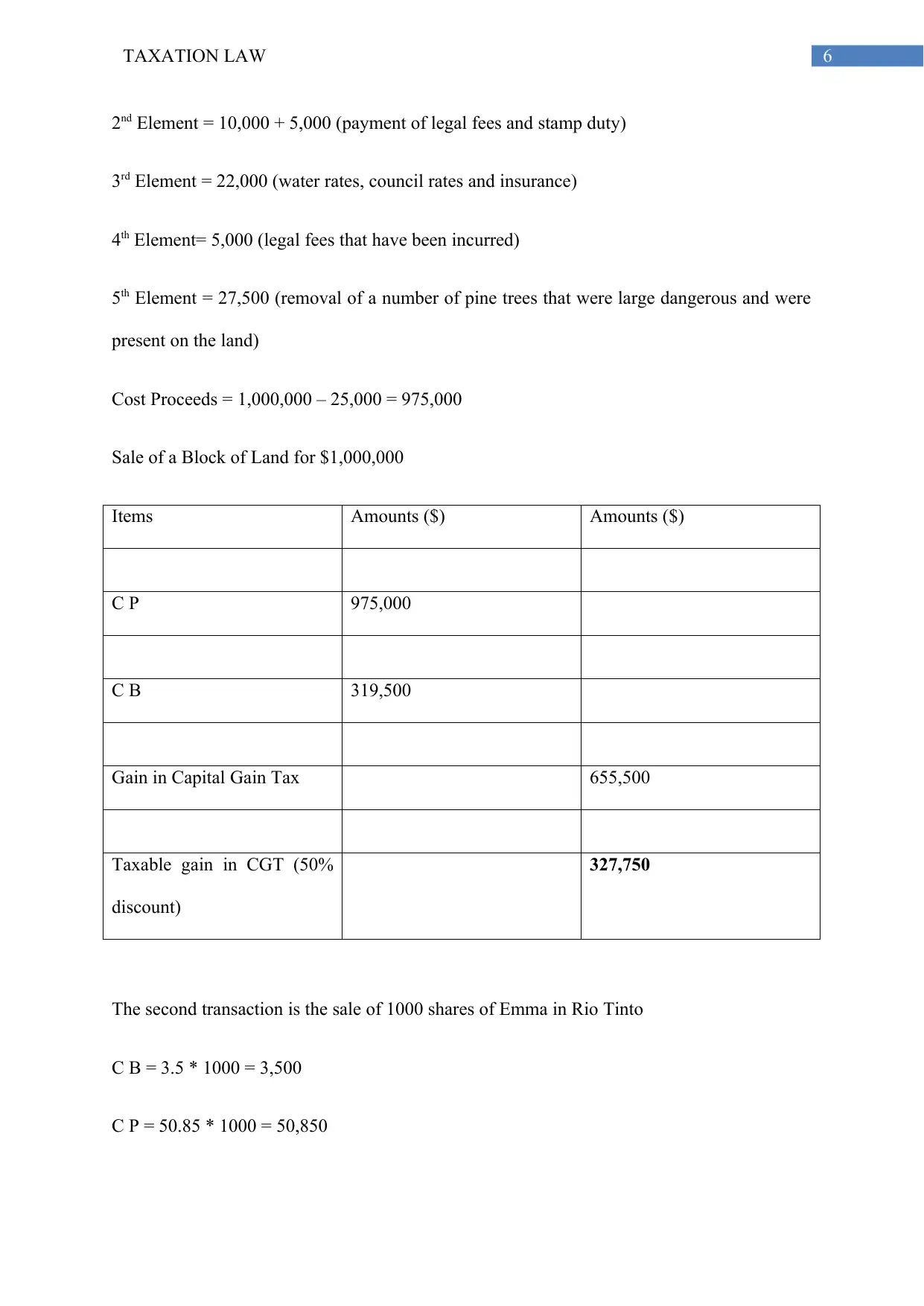
6TAXATION LAW
2nd Element = 10,000 + 5,000 (payment of legal fees and stamp duty)
3rd Element = 22,000 (water rates, council rates and insurance)
4th Element= 5,000 (legal fees that have been incurred)
5th Element = 27,500 (removal of a number of pine trees that were large dangerous and were
present on the land)
Cost Proceeds = 1,000,000 – 25,000 = 975,000
Sale of a Block of Land for $1,000,000
Items Amounts ($) Amounts ($)
C P 975,000
C B 319,500
Gain in Capital Gain Tax 655,500
Taxable gain in CGT (50%
discount)
327,750
The second transaction is the sale of 1000 shares of Emma in Rio Tinto
C B = 3.5 * 1000 = 3,500
C P = 50.85 * 1000 = 50,850
2nd Element = 10,000 + 5,000 (payment of legal fees and stamp duty)
3rd Element = 22,000 (water rates, council rates and insurance)
4th Element= 5,000 (legal fees that have been incurred)
5th Element = 27,500 (removal of a number of pine trees that were large dangerous and were
present on the land)
Cost Proceeds = 1,000,000 – 25,000 = 975,000
Sale of a Block of Land for $1,000,000
Items Amounts ($) Amounts ($)
C P 975,000
C B 319,500
Gain in Capital Gain Tax 655,500
Taxable gain in CGT (50%
discount)
327,750
The second transaction is the sale of 1000 shares of Emma in Rio Tinto
C B = 3.5 * 1000 = 3,500
C P = 50.85 * 1000 = 50,850
Paraphrase This Document
Need a fresh take? Get an instant paraphrase of this document with our AI Paraphraser
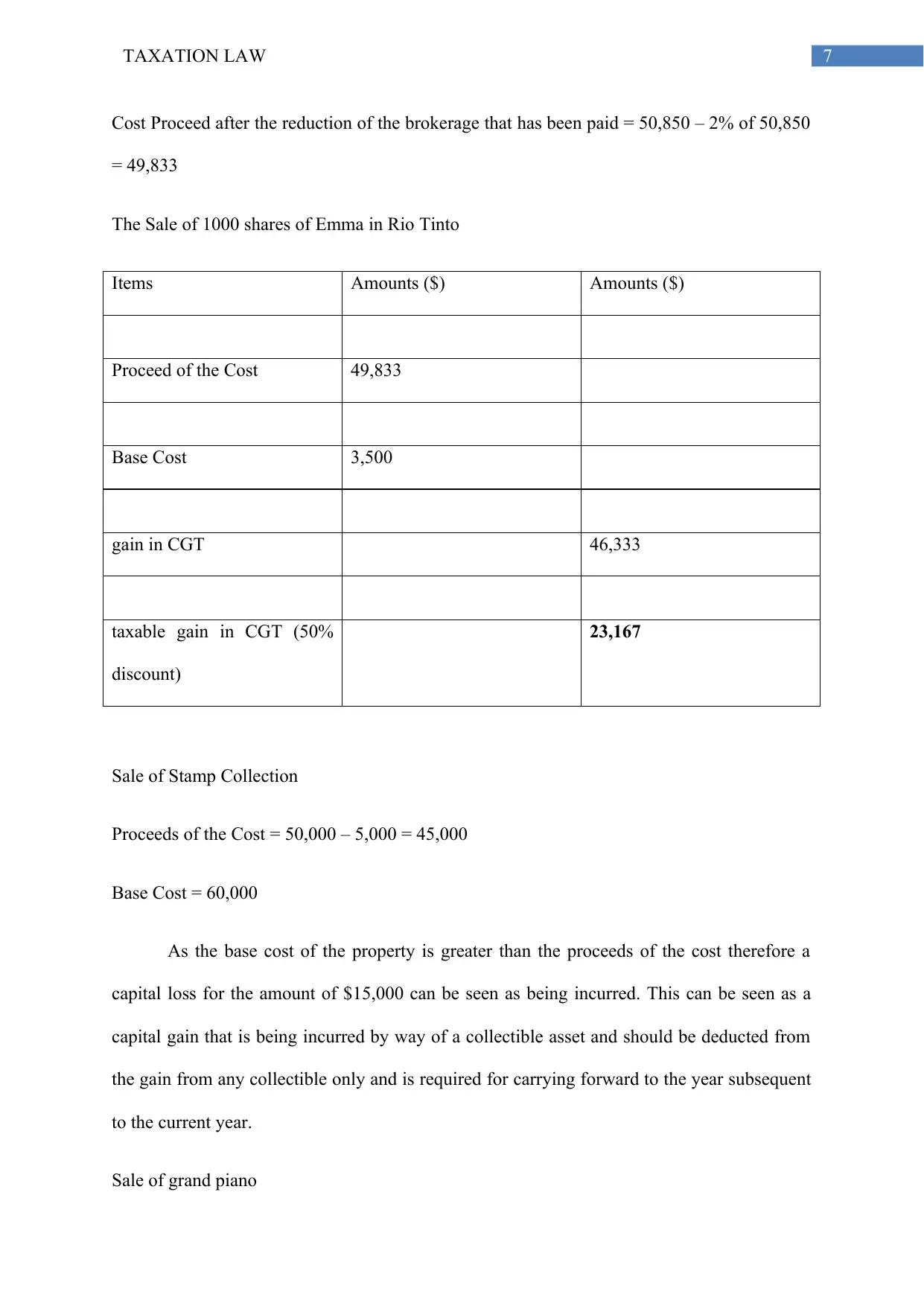
7TAXATION LAW
Cost Proceed after the reduction of the brokerage that has been paid = 50,850 – 2% of 50,850
= 49,833
The Sale of 1000 shares of Emma in Rio Tinto
Items Amounts ($) Amounts ($)
Proceed of the Cost 49,833
Base Cost 3,500
gain in CGT 46,333
taxable gain in CGT (50%
discount)
23,167
Sale of Stamp Collection
Proceeds of the Cost = 50,000 – 5,000 = 45,000
Base Cost = 60,000
As the base cost of the property is greater than the proceeds of the cost therefore a
capital loss for the amount of $15,000 can be seen as being incurred. This can be seen as a
capital gain that is being incurred by way of a collectible asset and should be deducted from
the gain from any collectible only and is required for carrying forward to the year subsequent
to the current year.
Sale of grand piano
Cost Proceed after the reduction of the brokerage that has been paid = 50,850 – 2% of 50,850
= 49,833
The Sale of 1000 shares of Emma in Rio Tinto
Items Amounts ($) Amounts ($)
Proceed of the Cost 49,833
Base Cost 3,500
gain in CGT 46,333
taxable gain in CGT (50%
discount)
23,167
Sale of Stamp Collection
Proceeds of the Cost = 50,000 – 5,000 = 45,000
Base Cost = 60,000
As the base cost of the property is greater than the proceeds of the cost therefore a
capital loss for the amount of $15,000 can be seen as being incurred. This can be seen as a
capital gain that is being incurred by way of a collectible asset and should be deducted from
the gain from any collectible only and is required for carrying forward to the year subsequent
to the current year.
Sale of grand piano
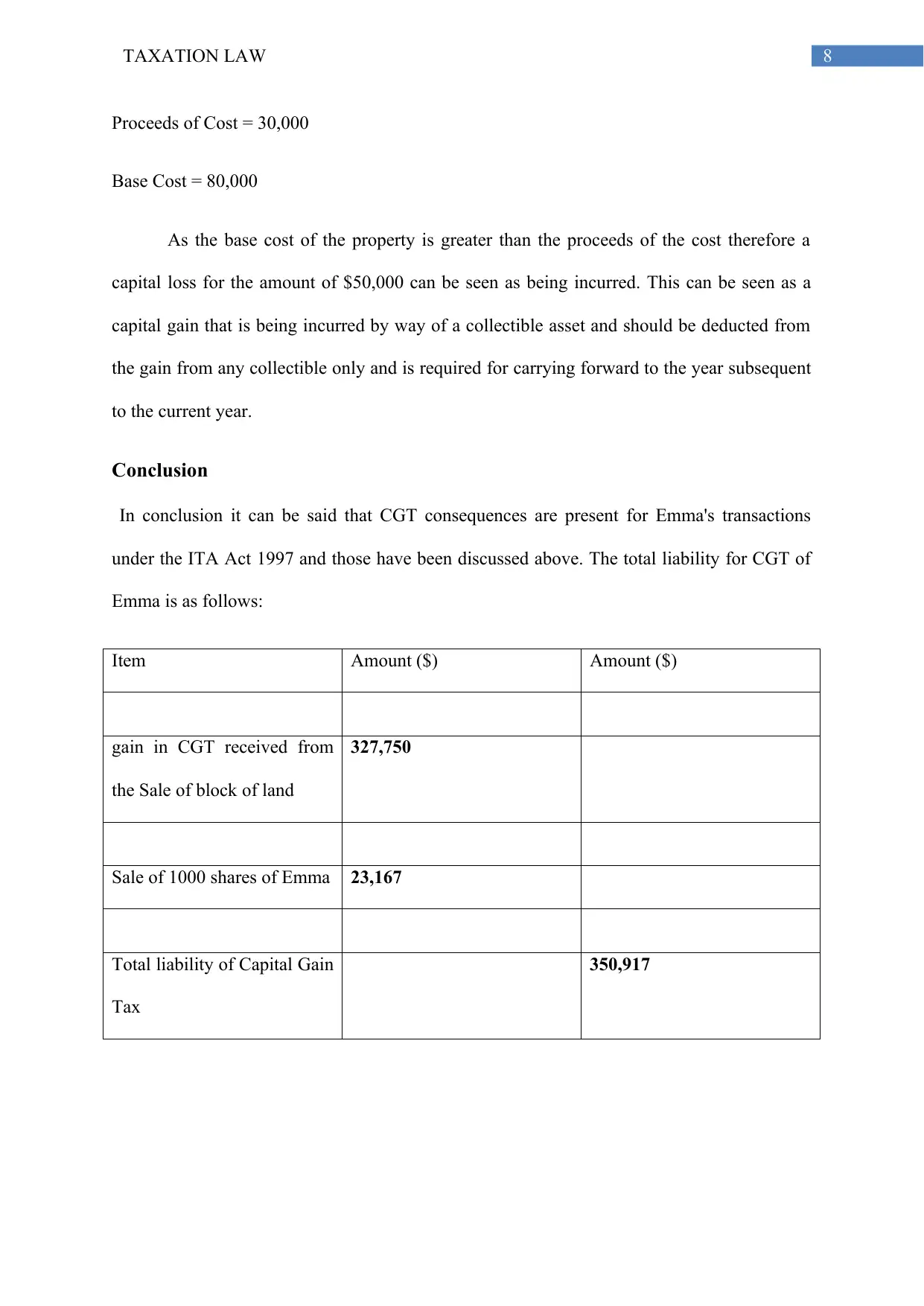
8TAXATION LAW
Proceeds of Cost = 30,000
Base Cost = 80,000
As the base cost of the property is greater than the proceeds of the cost therefore a
capital loss for the amount of $50,000 can be seen as being incurred. This can be seen as a
capital gain that is being incurred by way of a collectible asset and should be deducted from
the gain from any collectible only and is required for carrying forward to the year subsequent
to the current year.
Conclusion
In conclusion it can be said that CGT consequences are present for Emma's transactions
under the ITA Act 1997 and those have been discussed above. The total liability for CGT of
Emma is as follows:
Item Amount ($) Amount ($)
gain in CGT received from
the Sale of block of land
327,750
Sale of 1000 shares of Emma 23,167
Total liability of Capital Gain
Tax
350,917
Proceeds of Cost = 30,000
Base Cost = 80,000
As the base cost of the property is greater than the proceeds of the cost therefore a
capital loss for the amount of $50,000 can be seen as being incurred. This can be seen as a
capital gain that is being incurred by way of a collectible asset and should be deducted from
the gain from any collectible only and is required for carrying forward to the year subsequent
to the current year.
Conclusion
In conclusion it can be said that CGT consequences are present for Emma's transactions
under the ITA Act 1997 and those have been discussed above. The total liability for CGT of
Emma is as follows:
Item Amount ($) Amount ($)
gain in CGT received from
the Sale of block of land
327,750
Sale of 1000 shares of Emma 23,167
Total liability of Capital Gain
Tax
350,917
⊘ This is a preview!⊘
Do you want full access?
Subscribe today to unlock all pages.

Trusted by 1+ million students worldwide
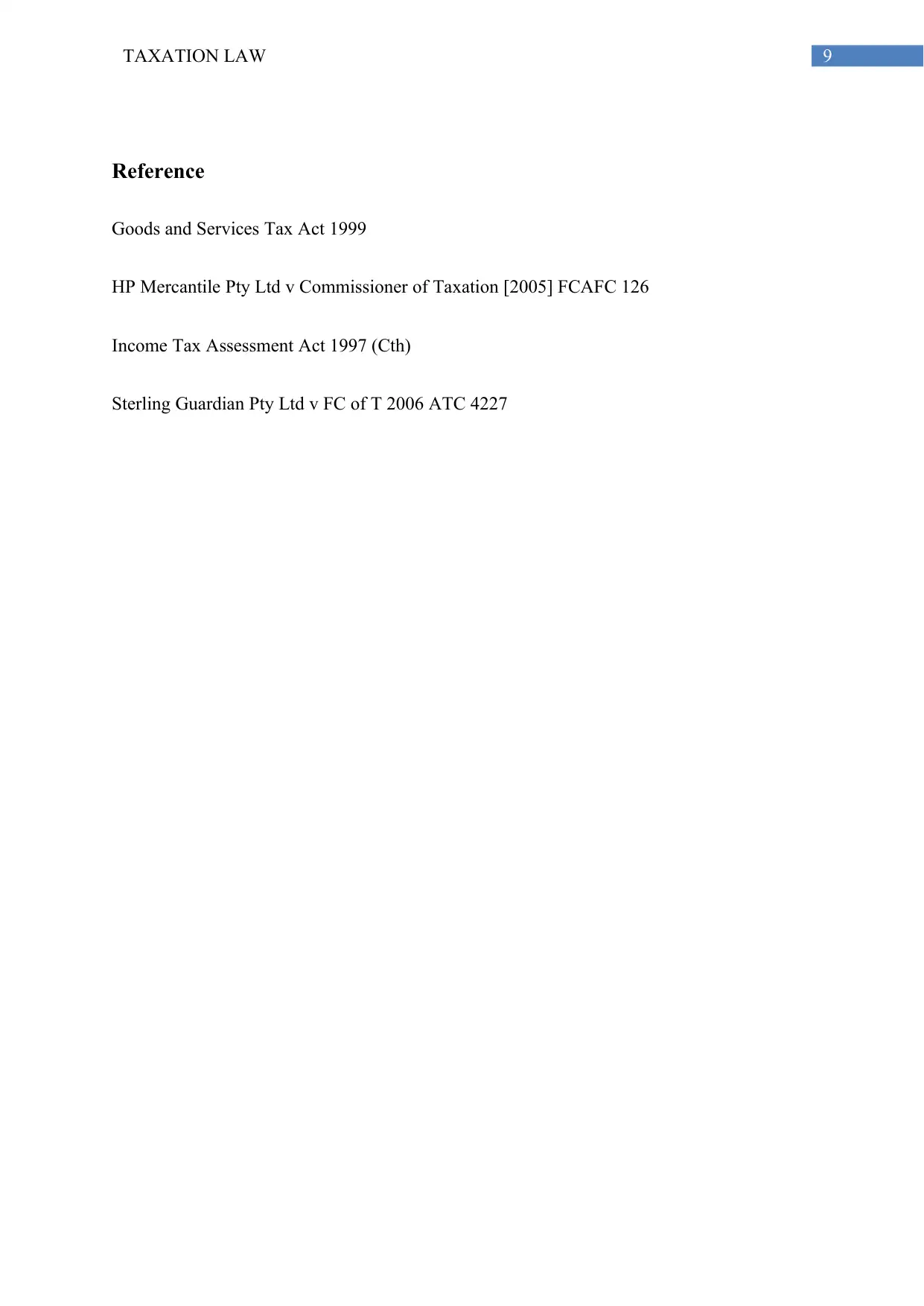
9TAXATION LAW
Reference
Goods and Services Tax Act 1999
HP Mercantile Pty Ltd v Commissioner of Taxation [2005] FCAFC 126
Income Tax Assessment Act 1997 (Cth)
Sterling Guardian Pty Ltd v FC of T 2006 ATC 4227
Reference
Goods and Services Tax Act 1999
HP Mercantile Pty Ltd v Commissioner of Taxation [2005] FCAFC 126
Income Tax Assessment Act 1997 (Cth)
Sterling Guardian Pty Ltd v FC of T 2006 ATC 4227
1 out of 10
Related Documents
Your All-in-One AI-Powered Toolkit for Academic Success.
+13062052269
info@desklib.com
Available 24*7 on WhatsApp / Email
![[object Object]](/_next/static/media/star-bottom.7253800d.svg)
Unlock your academic potential
Copyright © 2020–2025 A2Z Services. All Rights Reserved. Developed and managed by ZUCOL.





